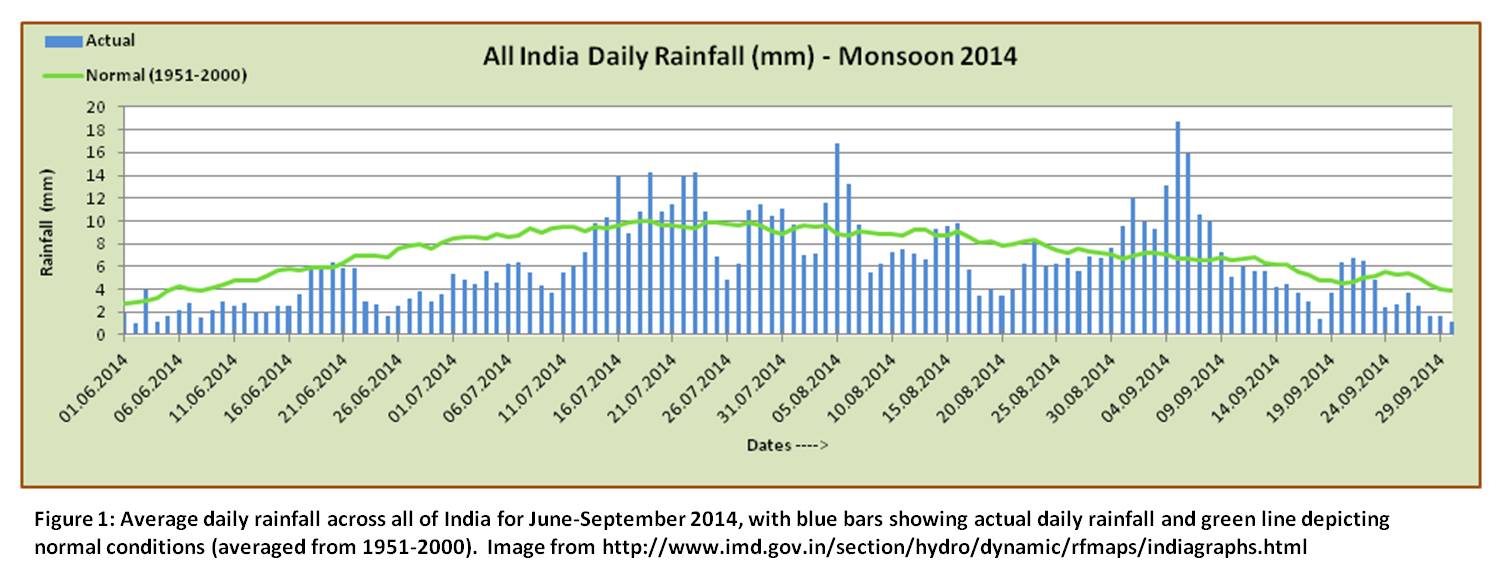Research in the Department is currently focusing on various aspects of the Indian summer monsoon, including (but not limited to) onset and withdrawal dates, active and break cycles, interannual variability and how land surface processes (such as increasing irrigation) may influence monsoon rainfall. The monsoon is, however, a real-life phenomenon, impacting the lives of millions of people across India. Although studies have suggested little or no long-term change in seasonal mean rainfall over the last century (e.g. Goswami et al. 2006), year-to-year variability can be significant, as well as regional variation. What follows is a brief summary of this year’s monsoon.
Figure 1 shows average daily rainfall across India for the 2014 summer monsoon (IMD 2014). According to this, the monsoon began slowly and with below-average rainfall, not picking up and meeting normal conditions until mid-July. Rainfall then exceeded normal conditions for much of July and early August, dropping below normal again before a final peak (well above normal conditions) during late August and early September. Overall, the 2014 monsoon ended with 12% below average rainfall, which began as 43% below average after June and was only slightly saved by the late surge (Reuters 2014).
The spatial variation of rainfall during this year’s monsoon is shown in Figure 2 (IMD 2014), with much of India receiving less rainfall than normal conditions but especially so in northern regions; only eastern India around the Odisha region and the Western Ghats received more rainfall than normal.
Being a physical geographer at heart, however, I am as much interested in the societal impacts of monsoon variability as I am in its physical characteristics. This year’s monsoon is quoted as being the worst in 5 years, with only the late surge in early September helping to avoid a widespread drought (Reuters 2014). This late surge in rainfall, and delayed withdrawal of the monsoon, helped to boost grain and rice production in northern regions, however summer harvests are expected to suffer because of the poor beginning to the monsoon (Reuters 2014). This dry beginning resulted in the northern states of Haryana and Uttar Pradesh declaring droughts and necessitating government subsidies to maintain irrigation systems (Reuters 2014). Conversely the late surge in rainfall caused flash floods in northern and eastern regions, such as nearly 1500 villages being inundated across Uttar Pradesh, resulting in many deaths and thousands being made homeless (Gulf Times 2014). Some of the consequences of this flooding can be seen in Figure 3.
The Indian summer monsoon, therefore, is a very active and significant feature, and is highly influential for millions of people across India and beyond, throughout Southeast Asia. Further research is needed, and is currently being undertaken by people in the Department, to understand its characteristics in a changing climate, however this should not take away from the fact that it has enormous societal importance on a daily basis.
References
Goswami, B., Venugopal, V., Sengupta, D., Madhusoodanan, M. & Xavier, P., 2006. Increasing Trend of Extreme Rain Events Over India in a Warming Environment, Science, 314: 1442-1445
Gulf Times, 2014. ‘1,500 villages under water in North India’. Islamic Information Portal. http://islam.ru/en/content/story/1500-villages-under-water-north-india. Accessed 23/11/14
IMD, 2014. ‘Monsoon’. India Meteorological Department. http://www.imd.gov.in/section/nhac/dynamic/Monsoon_frame.htm. Accessed 23/11/14
Reuters, 2014. ‘India’s 2014 monsoon ends with double-digit rain deficit’. Reuters. http://in.reuters.com/article/2014/09/30/india-monsoon-idINKCN0HP1HI20140930. Accessed 23/11/14



